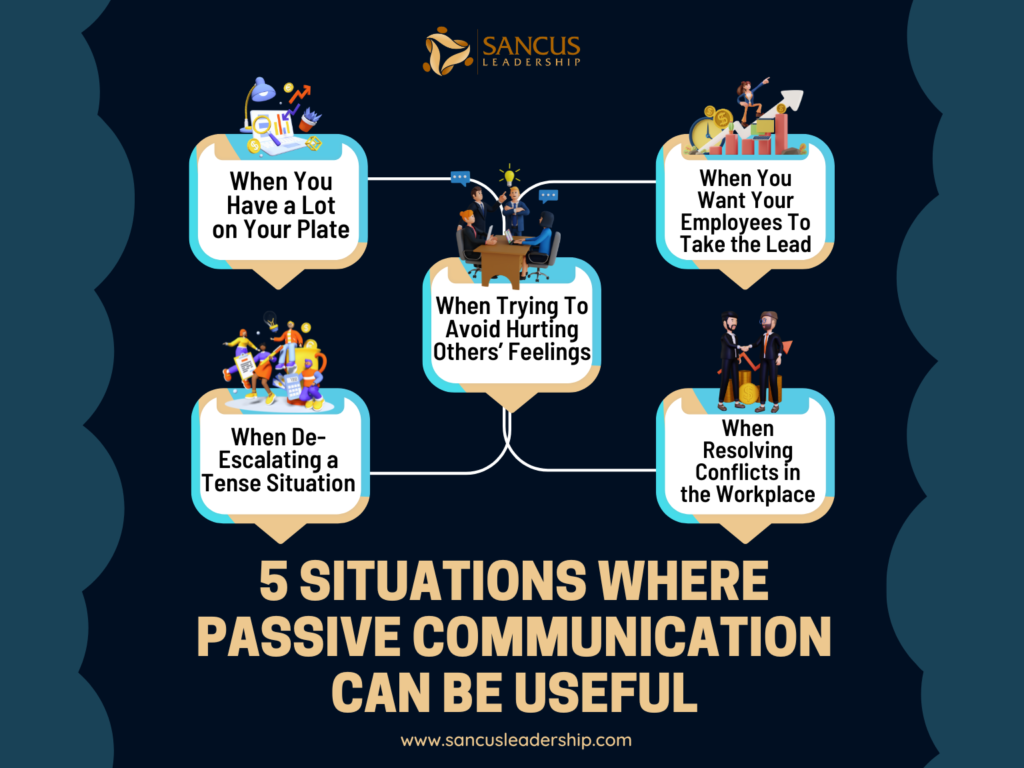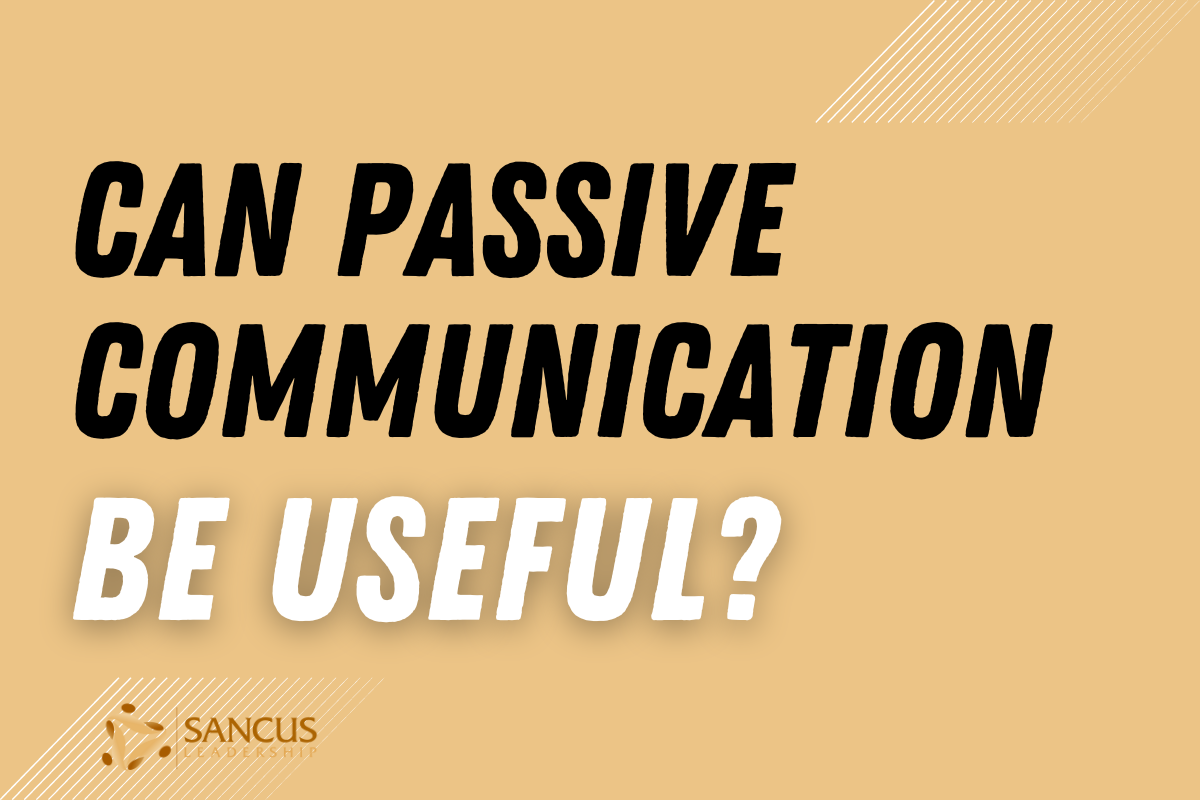Passive communicator avoids sharing their opinions, ideas, and feelings on even the most crucial issues in the workplace, especially in a group setting. They shy away from the spotlight, let others shine, and take the lead. Passive communication is typically deemed detrimental since it affects one’s self-confidence and sense of ownership, but it certainly has benefits, too, depending on when you utilize it.
Passive communication can be helpful when being assertive and opinionated brings more harm than good. Go this route when resolving conflicts, diffusing tension, and preparing employees for higher roles. It’s also best when protecting others’ feelings and when delegating tasks.
Passive communication can be helpful when being assertive and opinionated brings more harm than good.
This article will cover five situations where a passive communication style is more beneficial than others and how to utilize it to promote your employees’ and team’s best interests. We will discuss how passive communication is advantageous when delegating tasks, training employees for leadership roles, resolving conflicts and tense situations, protecting employees’ sentiments, and at times when you have your hands full. Let’s start!
What is really the importance of language in small team leadership?
Situations Where Passive Communication Can Be Useful

Being a passive communicator is often frowned upon in business because it is associated with being lackadaisical, mediocre, and a pushover. However, this communication style can be beneficial in specific scenarios, and it can certainly be used to achieve particular results.
Passive communication (rather than assertive) should be used when being straightforward and powerful will cause more harm than good. Here are some examples:
1. When You Want Your Employees To Take the Lead
Leading and managing a team doesn’t mean you call the shots at all times. You also have to train your employees to be more independent and learn how to make sound decisions for themselves and the entire team. Passive communication is helpful in this scenario because it allows you to take a backseat and let your employees take the reins.
Leading and managing a team doesn’t mean you call the shots at all times.
Say you’re launching a new project and want your employees to be more cooperative and take ownership of the processes involved. Rather than spearheading the planning and implementation stages, take on a passive communicator’s stance and let them think for themselves and make decisions on their own.
This is also a great way to get to know your employees better. Some of their strengths will shine, particularly those with strong leadership skills. You’ll identify employees who need more training and guidance regarding decision-making and collaborative skills. You’ll also get a glimpse of how team dynamics work and whether or not there are pressing issues to be addressed so they can work more synergistically.
2. When Resolving Conflicts in the Workplace
Conflicts in the workplace are unavoidable. This is especially true when you’re managing a group of people who all have different personalities. As a leader, you are expected to take control of the situation, especially when disputes threaten the team’s workflow and synergy.
However, sometimes, taking a step back and allowing the situation to unfold itself is the best route. Take a passive stance and enable your team members to take the lead in expressing their thoughts. Become a mere observer as your employees interact and communicate with each other as they try to settle conflicts among themselves.
In this scenario, not sharing your thoughts and opinions is advantageous since it eliminates the harmful effects of partiality. Naturally, after learning more about the conflict, you’ll lean toward one side of the whole equation, which might cause irreparable damage to your employees’ morale. Passive communication will not aggravate the situation and will help avoid further tension within the team.
Passive communication will not aggravate the situation and will help avoid further tension within the team.
In this scenario, not sharing your thoughts and opinions is advantageous since it eliminates the negative effects of partiality.
3. When You Have a Lot on Your Plate
When a lot is going on in your work and personal lives, and you’re starting to feel stressed and anxious, it might be a good idea to step back and let others take control. Passive communicators allow others to take the reins without offering too much resistance. Doing so will benefit your mental health and give you a much-needed break from tension and responsibilities.
As a leader, this is also a great way to delegate tasks to your team. Rather than being the point person for every minute aspect of the business, turning over some of the responsibility to deserving and qualified employees will give you a clearer picture of their strengths and weaknesses. Take this as an opportunity for you to train and prepare employees for career advancement.
4. When De-Escalating a Tense Situation
When you find yourself in a situation where things feel spiraling out of control, with outbursts and violence seeming to loom on the horizon, it’s best to take things down a notch by momentarily withdrawing and taking a step back. This will hopefully neutralize the situation and alleviate the individuals involved.
Allow each party to air their grievances and hold your comments and judgment for later. Avoid adding fuel to the fire by making your interpretations and conclusions. Hold your tongue until both sides are satisfied with everything they’ve divulged. Only then should you gather all information and invite the parties to discuss, address misconceptions, compromise, and agree to settle.
Taking on a passive stance — albeit temporarily — will significantly help diffuse rising tensions within the team. This communication style is perhaps the best option in situations like these because it allows you to help de-escalate tense situations faster and see how your employees handle disputes. It will enable you to peek into their true character, from where you can assess strengths, weaknesses, and areas for potential improvement.
Taking on a passive stance — albeit temporarily — will significantly help in diffusing rising tensions within the team.
5. When Trying To Avoid Hurting Others’ Feelings
As a leader, there are times when you must hold your tongue to spare your employees from getting hurt or upset. Perhaps it’s to keep them from embarrassment, or you won’t make them feel uninspired about a specific task or project. It could also be a show of support and respect to an employee going through a rough patch in their personal life, negatively affecting their work performance..
In such circumstances, a passive communication style saves the day. You can use minimal words to convey crucial, relevant information to employees while reserving your opinions and ideas for later. Ultimately, your employees will realize how you adapted to the situation and prioritized their feelings and perspectives. After all, leading and managing a team is not all about team growth and success — it’s also about respect, camaraderie, and teamwork.
You can use minimal words to convey crucial, relevant information to employees while reserving your opinions and ideas for later.

| When Is Passive Communication Useful? | Explanation |
| When You Want Your Employees To Take the Lead | You also have to train your employees to be more independent and learn how to make sound decisions for themselves and the entire team. Passive communication is helpful in this scenario because it allows you to take a backset and let your employees take the reins. |
| When Resolving Conflicts in the Workplace | You also have to train your employees to be more independent and learn how to make sound decisions for themselves and the entire team. Passive communication is helpful in this scenario because it allows you to take a backseat and let your employees take the reins. |
| When You Have a Lot on Your Plate | When a lot is going on in your work and personal lives, and you’re starting to feel stressed and anxious, it might be a good idea to step back and let others take control. Passive communicators allow others to take the reins without offering too much resistance. |
| When De-Escalating a Tense Situation | When you find yourself in a situation where things feel spiraling out of control, with outbursts and violence seeming to loom on the horizon, it’s best to take things down a notch by momentarily withdrawing and taking a step back. |
| When Trying To Avoid Hurting Others’ Feelings | As a leader, there are times when you must hold your tongue to spare your employees from getting hurt or upset. Perhaps it’s to keep them from embarrassment, or you won’t make them feel uninspired about a specific task or project. |
The short video below explains the characteristics of Good Communication and how it plays a huge role in building good relationships at work.
Final Thoughts
Passive communication has its pros and cons. It hinders you from expressing your views and taking a firm stand on contentious issues, but when utilized appropriately, it can be an effective tool to lead and manage a team toward growth and success.
You can use it to train individuals for leadership roles and coach them in taking on more challenging tasks. It can also help when protecting your employee’s feelings and when you’re up to your ears in work and need others to take on more responsibilities. Passive communication also comes in handy when resolving conflicts and diffusing tension.



